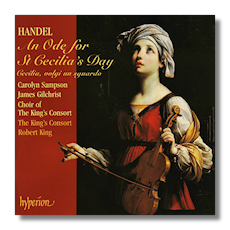
The Internet's Premier Classical Music Source
Related Links
- Handel Reviews
- Latest Reviews
- More Reviews
-
By Composer
-
Collections
DVD & Blu-ray
Books
Concert Reviews
Articles/Interviews
Software
Audio
Search Amazon
Recommended Links
Site News
 CD Review
CD Review
George Frideric Handel

An Ode for St. Cecilia's Day
- An Ode for St. Cecilia's Day, HWV76
- Cecilia, volgi un sguardo, HWV89
Carolyn Sampson, soprano
James Gilchrist, tenor
Choir Of The King's Consort
The King's Consort/Robert King
Hyperion CDA67463
An Ode for St. Cecilia's Day is a splendid CD – one that all Handelians will want to buy immediately and one that anyone with an interest in Baroque choral and vocal music really can't afford to overlook. It's wonderfully played by the musicians assembled, each specialist weighing in to the full with a convincing and very high-quality contribution. Then the whole is greater than the sum of the parts by a long, long way.
Such extrovert and 'open' music as the Dryden ode, HWV76, could all too easily be overplayed, rushed and otherwise spoilt by highlighting its pomp and shine. Once you have heard the overture settle into the From harmony, from heav'nly harmony recitative, it's clear that Robert King and his superb forces, especially soloists Carolyn Sampson and James Gilchrist (who – as Baroque soloists – are about as good as it gets), are going to let the energy and splendor come from within the music itself and not dress it up with spurious effect.
The legitimacy of Saint Cecilia as patron of music is a somewhat shaky one, originating two hundred years before Handel, when musicians were becoming conscious of their identities as what we might call 'professionals' and interpreted texts from antiquity to support their search for a Christian patron. What's more, for most of the seventeenth century (when Protestants were in the ascendant over the 'Old faith') veneration of Cecilia was secret – until 1683, when a group in Britain called (fittingly) 'The Musical Society' began a series of concerts on November 22nd each year until 1703; Purcell's Welcome to all the pleasures and Hail! bright Cecilia were written for the celebratory events of 1683 and 1692 respectively. By the time Handel first came to London in 1710, the Cecilian festivals had ended, though the composition of Odes had not. Yet it was not until the 1730s that Handel presented English choral works at his Italian opera series. In 1736 he set Dryden's Alexander's Feast and paired its performance with the Italian cantata, Cecilia, volgi un sguardo. That was more of a success than the coupling, three years later, of the two odes by Dryden, Alexander's Feast again, this time with A Song for St. Cecilia's Day.
This recording, however, couples the Italian cantata, Cecilia, volgi un sguardo (HWV 89, 1736) with the shorter English ode, usually entitled An Ode for St. Cecilia's Day (HWV 76, 1739) after its publication by Randall in 1771 The scope of the latter is nothing if not ambitious… Dryden envisages for music a central role in the origin and disappearance of the Universe:
From harmony, from heav'nly harmony
This universal frame began
…
So when the last and dreadful hour
This crumbling pageant shall devour,
The trumpet shall be heard on high,
The dead shall live, the living die,
And Music shall untune the sky
Quite reasonable, really!
This was obviously music with which Handel was pleased – he used the overture as the basis for his Opus 6, No 5, concerto soon afterwards; he used trumpets (Crispian Steele-Perkins is in his usual outstanding form here) for war-like effects; and wrote in a highly-colored yet delicate fashion for the flute (Rachel Brown) cello (Jonathan Cohen) and organ. It's this desire of Handel's to match text with themes and textures… energetically, forcefully, yet from a position of strength and admiration (of Dryden's sentiments and intentions) that Robert King, the Consort and soloists have captured so well on this disk. Again, special mention must go to Carolyn Sampson for a purity of tone, for such an active (neither 'forward' nor self-conscious, but genuinely involved) presence and for such wonderful diction.
There is much of Cecilia, volgi un sguardo that ties it to Alexander's Feast, having been first performed between the latter's two halves for performers associated with the longer work. It's more florid and less all-embracing than An Ode for St. Cecilia's Day itself and lasts a little over half as long. It makes a pleasant contrast here and highlights particularly James Gilchrist's tenor to all our advantages: he's superb… convincing, lucid, authoritative. For effect, though, you might want to set your CD player to the tracks (16 – 25) of Cecilia, volgi before enjoying the adult majesty of An Ode. Either way, don't miss a note!
The recording is excellent: spacious, relaxed and in a favorite location for King et al – St-Jude-on-the-Hill near London with its controlled, not unduly flattering yet quite appropriate acoustic. The liner notes are informative and include the texts in English, (Italian), French and German. The only serious rival is Pinnock on Archiv (nla). So, again, do not hesitate to buy this excellent recording. Thoroughly recommended in every respect.
Copyright © 2007, Mark Sealey




















